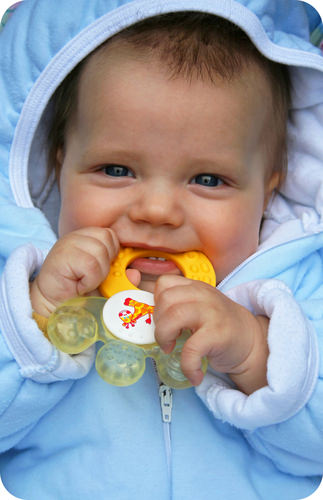11.73: Infancy and Childhood
- Page ID
- 14419

Does a baby learn much during his first year?
The first years of life are full of important milestones as new skills are mastered. For example, at first this baby wasn't even able to roll over on his stomach or hold up his head!
Infancy and Childhood
The first year after birth is called infancy. Infancy is a period when the baby grows very fast. During infancy, the baby doubles in length and triples in weight. Other important changes also happen during infancy:
- The baby's teeth start to come in, usually at about six months of age (Figure below).
- The baby starts smiling, paying attention to other people, and grabbing toys.
- The baby begins making babbling sounds. By the end of the first year, the baby is starting to say a few words, such as “mama” and “dada.”
- The baby learns to sit, crawl, and stand. By the end of the first year, the baby may be starting to walk.

Childhood begins after the baby’s first birthday and continues until the teen years. Between one and three years of age, a child is called a toddler. During the toddler stage, growth is still fast, but not as fast as it was during infancy. A toddler learns many new words. The child even starts putting together words in simple sentences. Motor skills also develop quickly during this stage. By age three, most children can run and climb steps. They can hold crayons and scribble with them. They can also feed themselves and use the toilet.
From age three until the teens, growth is slower. The body also changes shape. The arms and legs get longer compared to the trunk. Children continue to develop new motor skills. For example, many young children learn how to ride a tricycle and then a bicycle. Most also learn how to play games and sports (Figure below). By age six, children start losing their baby teeth. Their permanent teeth begin coming in to replace them. They also start school and learn how to read and write. They develop friendships and become less dependent on their parents.

Early Childhood Development
There are numerous milestones that occur during the first few years of childhood. These include
- the use of language,
- walking and running,
- understanding simple concepts,
- pretend play,
- the development of fine motor skills,
- the development of independence,
- having temper tantrums,
- demonstrating separation anxiety,
- becoming fully potty-trained,
- showing natural curiosity.
Science Friday: The Real Guide to Imaginary Companions
Children often have imaginary friends of various shapes and sizes. In this two-part video series by Science Friday, psychologists Marjorie Taylor and Tracy Gleason discuss why kids create these companions, and the roles that these companions play in development.
Science Friday: Babies on the Brink
Developmental psychologists believe that infants learn to fear heights as they learn to crawl. In this video by Science Friday, Karen Adolph of NYU's Infant Action Lab has reveals that while babies can learn from experiences near high ledges or narrow bridges, it's not a phobia they acquire.
Summary
- The first year after birth is called infancy, after which childhood begins.
- An individual grows quickly and develops new abilities during infancy and childhood.
Explore More
Use the resource below to answer the questions that follow.
- Infancy Studies Laboratory at http://www.youtube.com/watch?v=t_Y6wNWbNuE (2:07)
- At what age do the researchers like to see infants to study cognitive development?
- Why is it important to establish a baseline in research of this nature?
- How do researchers hope to use information they are collecting to help children with language problems?
Review
- What is infancy?
- What changes in size happen during infancy?
- What is a toddler?
- List three milestones of early childhood.

